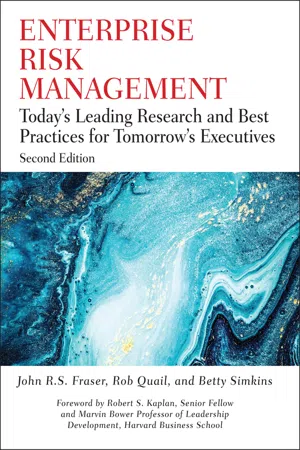
Enterprise Risk Management
Today's Leading Research and Best Practices for Tomorrow's Executives
- English
- ePUB (mobile friendly)
- Available on iOS & Android
Enterprise Risk Management
Today's Leading Research and Best Practices for Tomorrow's Executives
About this book
Unlock the incredible potential of enterprise risk management
There has been much evolution in terms of ERM best practices, experience, and standardsandregulation over the past decade. Enterprise Risk Management: Today's Leading Research and Best Practices for Tomorrow's Executives, Second Edition isthe revised and updated essential guide to the now immensely popular topic ofenterpriserisk management(ERM).With contributions fromleading academics and practitioners, this book offersinsights into what practitioners are doingandwhatthe future holds. You'll discoverhow you canimplement best practices, improve ERM tools and techniques, and even learn to teach ERM.Retaining the holistic approach to ERM that made the first edition such a success, this new edition adds coverage of new topics including cybersecurityrisk, ERM in government, foreignexchangerisk, risk appetite, innovation risk, outsourcing risk, scenario planning, climate change risk, and much more.In addition, the new edition includes important updates and enhancements to topics covered in the first edition; so much of it has been revised and enhanced that it is essentiallyan entirelynew book.
Enterprise Risk Management introduces you to the concepts and techniquesthat allow you toidentifyrisks and prioritize the appropriate responses. This invaluable guide offers a broad overview, covering key issueswhile focusing on the principles thatdrive effectivedecision making anddeterminebusiness success. This comprehensive resource alsoprovides a thorough introduction toERMas it relates to credit, market, and operational risk, as well as the evolving requirements ofthe board of directors' role in overseeing ERM.
Through the comprehensive chapters and leading research and best practices covered, this book:
- Provides a holistic overview of key topics in ERM, includingthe role of the chief risk officer, development and use ofkeyrisk indicatorsandtherisk-basedallocation of resources
- Contains second-edition updates covering additional material related to teaching ERM, risk frameworks, risk culture, credit and market risk, risk workshops and risk profilesand much more. Over 90% of the content from the first edition has been revised or enhanced
- Reveals how you can prudently apply ERMbestpracticeswithin the context of your underlying business activities
Filled with helpfulexamples, tables, andillustrations, Enterprise Risk Management, Second Edition offers a wealth of knowledge on the drivers, the techniques, the benefits, as well as the pitfalls to avoid, in successfully implementingERM.
Frequently asked questions
- Essential is ideal for learners and professionals who enjoy exploring a wide range of subjects. Access the Essential Library with 800,000+ trusted titles and best-sellers across business, personal growth, and the humanities. Includes unlimited reading time and Standard Read Aloud voice.
- Complete: Perfect for advanced learners and researchers needing full, unrestricted access. Unlock 1.4M+ books across hundreds of subjects, including academic and specialized titles. The Complete Plan also includes advanced features like Premium Read Aloud and Research Assistant.
Please note we cannot support devices running on iOS 13 and Android 7 or earlier. Learn more about using the app.
Information
PART I
Overview and Drivers of Enterprise Risk Management
CHAPTER 1
Enterprise Risk Management: An Introduction and Overview
It's not the strongest of the species that survives, nor the most intelligent, but those that are the most responsive to change.—Often attributed to Charles Darwin, British naturalist
Prediction is very difficult, especially if it's about the future.—Niels Bohr, 1922 Nobel Laureate in Physics
WHAT IS ENTERPRISE RISK MANAGEMENT?
DRIVERS OF ENTERPRISE RISK MANAGEMENT
Table of contents
- Cover
- Table of Contents
- Title Page
- Copyright
- Foreword to the Second Edition
- Foreword to the First Edition
- PART I: Overview and Drivers of Enterprise Risk Management
- PART II: Enterprise Risk Management, Culture, and Control
- PART III: ERM Tools and Techniques
- PART IV: Types of Risk
- PART V: Special Topics and Case Studies
- Index
- End User License Agreement